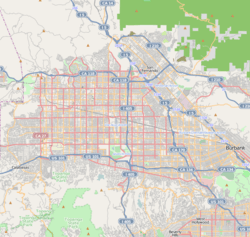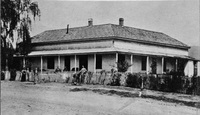Mission San Fernando Rey de España
|
Mission San Fernando Rey de España, circa 1910. | |
 Location in the San Fernando Valley | |
| Location |
15151 San Fernando Mission Blvd. Mission Hills, Los Angeles, California 91345 |
|---|---|
| Coordinates | 34°16′23″N 118°27′40″W / 34.2731°N 118.4612°WCoordinates: 34°16′23″N 118°27′40″W / 34.2731°N 118.4612°W |
| Name as founded | La Misión del Señor Fernando, Rey de España[1] |
| English translation | The Mission of Saint Ferdinand, King of Spain |
| Patron | Ferdinand III of Castile[2] |
| Nickname(s) | "Mission of the Valley"[3] |
| Founding date | September 8, 1797[4] |
| Founding priest(s) | Father Fermín Lasuén[5] |
| Founding Order | Seventeenth[2] |
| Military district | Second[6] |
| Native tribe(s) Spanish name(s) |
Tataviam, Tongva Fernandeno, Gabrielińo |
| Native place name(s) | 'Achooykomenga, Pasheeknga[7] |
| Baptisms | 2,784[8] |
| Marriages | 827[8] |
| Burials | 1,983[8] |
| Secularized | 1834 (Rancho Ex-Mission San Fernando)[2] |
| Returned to the Church | 1861[2] |
| Governing body | Roman Catholic Archdiocese of Los Angeles |
| Current use | Chapel-of-ease/Museum |
| Designated | 1971 |
| Delisted | 1974 |
| Reference no. | 71001076 |
| Designated | October 27, 1988 |
| Reference no. | 88002147 |
| Reference no. | #157 |
| Reference no. | 23[9] |
Mission San Fernando Rey de España is a Spanish mission in the Mission Hills district of Los Angeles, California. The mission was founded on September 8, 1797, and was the seventeenth of the twenty-one Spanish missions established in Alta California. Named for Saint Ferdinand, the mission is the namesake of the nearby city of San Fernando and the San Fernando Valley.
The mission was secularized in 1834 and returned to the Catholic Church in 1861; it became a working church in 1920. Today the mission grounds function as a museum; the church is a chapel of ease of the Archdiocese of Los Angeles.
History

In 1769, the Spanish Portola expedition, first Europeans to see inland areas of California, traveled north through the San Fernando Valley on August 7 and camped at a watering place near where the mission was later established in 1888 Fray Juan Crespi, a Franciscan missionary travelling with the expedition, noted in his diary that the camp was "at the foot of the mountains".[10]
Mission San Fernando Rey de España was founded on September 8, 1797 by Father Fermín Lasuén, making it the fourth mission site he had established in as many months. The prime location the padre selected had been occupied by Francisco Reyes (then Los Angeles' mayor). However, after brief negotiations construction of the first buildings was soon underway (Mission records list Reyes as godfather to the first infant baptized at San Fernando).[11]
Mission industries
The goals of the missions were, first, to spread the message of Christianity and, second, to establish a Spanish colony. Because of the difficulty of delivering supplies by sea, the missions had to become self-sufficient in relatively short order. Toward that end, neophytes were taught European-style farming, animal husbandry, mechanical arts and domestic crafts.
Mission bells
Bells were vitally important to daily life at any mission. The bells were rung at mealtimes, to call the Mission residents to work and to religious services, during births and funerals, to signal the approach of a ship or returning missionary, and at other times; novices were instructed in the intricate rituals associated with the ringing the mission bell.
A hundred-pound bell was unearthed in an orange grove near the Mission in 1920. It carried the following inscription (translated from Russian): "In the Year 1796, in the month of January, this bell was cast on the Island of Kodiak by the blessing of Archimandrite Joaseph, during the sojourn of Alexsandr Baranov." It is not known how this Russian Orthodox artifact from Kodiak, Alaska made its way to a Catholic mission in Southern California.
Later history
In 1842, six years before the California Gold Rush, a brother of the mission mayordomo (foreman) made the first Alta California gold discovery in the foothills near the mission. In memory of that discovery, the place was given the name Placerita Canyon, but only small quantities of gold were found.[5][12]
In 1845, Governor Pío Pico declared the Mission buildings for sale and, in 1846, made Mission San Fernando Rey de España his headquarters as Rancho Ex-Mission San Fernando. The Mission was utilized in a number of ways during the late 19th century: north of the mission was the site of Lopez Station for the Butterfield Stage Lines; it served as a warehouse for the Porter Land and Water Company; and in 1896, the quadrangle was used as a hog farm.[13] In 1861 the Mission buildings and 75 acres of land were returned to the church, after Charles Fletcher Lummis acted for preservation. The buildings were disintegrating, as beams, tiles and nails were taken from the church by settlers.[14] San Fernando's church became a working church again in 1923 when the Oblate priests arrived. Many attempts were made to restore the old Mission from the early 20th century, but it was not until the Hearst Foundation gave a large gift of money in the 1940s, that the Mission was finally restored. The museum became the repository for heirlooms of the Mexican church evacuated during the Cristero revolt, and also holds part of the Doheny library.[15] The church was listed on the National Register of Historic Places in 1971, but was extensively damaged by the 1971 San Fernando earthquake, and was completely rebuilt. Repairs were completed in 1974. It continues to be very well cared for and is still used as a chapel-of-ease. The Convento Building was separately listed on the Register in 1988. In 2003 comedian Bob Hope was interred in the Bob Hope Memorial Gardens; followed by his widow Dolores Hope in 2011.
In popular culture
- The sanctuary interior was used for Dragnet 1969's episode 15, "The Christmas Story".
- The tour interior and courtyard scenes of the Alamo in Pee-wee's Big Adventure were shot here in 1985.
- The tomb of Bob Hope is located at the San Fernando Mission Cemetery
Gallery
 A view looking down an exterior corridor at Mission San Fernando Rey de España, a common architectural feature of the Spanish Missions.
A view looking down an exterior corridor at Mission San Fernando Rey de España, a common architectural feature of the Spanish Missions. A view of the same location as at left, circa 1900.
A view of the same location as at left, circa 1900. The fountain opposite San Fernando Mission Road.
The fountain opposite San Fernando Mission Road. The present-day Mission façade.
The present-day Mission façade.- San Fernando Mission Church Interior.
 A statue of Father Junípero Serra and a native child at Mission San Fernando.
A statue of Father Junípero Serra and a native child at Mission San Fernando. Mission San Fernando Postcard, circa 1900
Mission San Fernando Postcard, circa 1900 Lopez Station in the 1860s.
Lopez Station in the 1860s.
See also
- Convento Building (Mission San Fernando)
- List of Los Angeles Historic-Cultural Monuments in the San Fernando Valley
- Rancho Ex-Mission San Fernando
- San Fernando Mission Cemetery
- USNS Mission San Fernando (AO-122) – a Mission Buenaventura Class fleet oiler built during World War II.
Notes
- ↑ Leffingwell, p. 49
- 1 2 3 4 Krell, p. 263
- ↑ Ruscin, p. 137
- ↑ Yenne, p. 148
- 1 2 Ruscin, p. 196
- ↑ Forbes, p. 202
- ↑ Ruscin, p. 195
- 1 2 3 Krell, p. 315: as of December 31, 1832; information adapted from Engelhardt's Missions and Missionaries of California.
- ↑ Los Angeles Department of City Planning (September 7, 2007). "Historic - Cultural Monuments (HCM) Listing: City Declared Monuments" (PDF). City of Los Angeles. Retrieved May 29, 2008.
- ↑ Bolton, Herbert E. (1927). Fray Juan Crespi: Missionary Explorer on the Pacific Coast, 1769-1774. HathiTrust Digital Library. p. 152. Retrieved April 2014. Check date values in:
|access-date=(help) - ↑ Young, p. 39
- ↑ California's First Real Gold, Leon Worden
- ↑ waterandpower.org, photos and history of the San Fernando Mission
- ↑ athanasius.com, Mission San Fernando Rey de España
- ↑ Davis, Mike City of Quartz London Vintage 1990 p.329 ISBN 0099998203
References
- Engelhardt, Zephyrin, O.F.M. (1922). San Juan Capistrano Mission. Standard Printing Co., Los Angeles, CA.
- Forbes, Alexander (1839). California: A History of Upper and Lower California. Smith, Elder and Co., Cornhill, London.
- Fedorova, Svetlana G., trans. & ed. by Richard A. Pierce and Alton S. Donnelly (1973). The Russian Population in Alaska and California: Late 18th Century – 1867. Limestone Press, Kingston, Ontario. ISBN 0-919642-53-5.
- Jones, Terry L. and Kathryn A. Klar (eds.) (2007). California Prehistory: Colonization, Culture, and Complexity. Altimira Press, Landham, MD. ISBN 0-7591-0872-2.
- Krell, Dorothy (ed.) (1979). The California Missions: A Pictorial History. Sunset Publishing Corporation, Menlo Park, CA. ISBN 0-376-05172-8.
- Paddison, Joshua (ed.) (1999). A World Transformed: Firsthand Accounts of California Before the Gold Rush. Heyday Books, Berkeley, CA. ISBN 1-890771-13-9.
- Ruscin, Terry (1999). Mission Memoirs. Sunbelt Publications, San Diego, CA. ISBN 0-932653-30-8.
- Wright, R. (1950). California's Missions. Hubert A. and Martha H. Lowman, Arroyo Grande, CA.
- Yenne, Bill (2004). The Missions of California. Thunder Bay Press, San Diego, CA. ISBN 1-59223-319-8.
- Young, S. & Levick, M. (1988). The Missions of California. Chronicle Books LLC, San Francisco, CA. ISBN 0-8118-3694-0.
External links
| Wikimedia Commons has media related to Mission San Fernando Rey de España. |
- Mass Times
- Elevation & Site Layout sketches of the Mission proper
- Andrés Pico Adobe
- Early photographs, sketches, land surveys of Mission San Fernando Rey de España, via Calisphere, California Digital Library
- Listing, photographs, and drawings of church at the Historic American Buildings Survey
- Listing and photographs of fountains at the Historic American Buildings Survey
- Listing, photographs, and drawings of monastery at the Historic American Buildings Survey
- Howser, Huell (December 8, 2000). "California Missions (102)". California Missions. Chapman University Huell Howser Archive.
